NDVI stands for "Normalized Difference Vegetation Index". NRG stands for "Near-infrared / Red / Green". NDVI and NRG are both ways to visualize the amounts of infrared and other wavelengths of light reflected from vegetation. Because both these methods compare ratios of blue and red light absorbed versus green and IR light reflected, they can be used to evaluate the health of vegetation. It's a snapshot of how much photosynthesis is happening. This is helpful in assessing vegetative health or stress. (Read more here: https://www.agronomy.org/publications/jeq/articles/36/3/832) ## Do-It-Yourself These techniques for vegetation analysis were developed for satellite imagery, but at Public Lab, we've been working a lot on capturing infrared imagery using our DIY [near-infrared camera](/wiki/near-infrared-camera) setup, and combining it with visible bands to produce NDVI images such as the one above. ## What these images mean What exactly are these images we're trying to make? What do they tell us about vegetation, and why? These diagrams should help to understand what it is we're doing and why these are good ways to analyze plant life. ## The NDVI equation [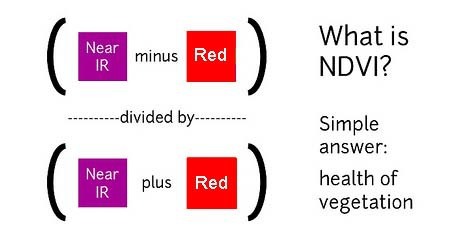](/i/44723) **NDVI = (Near Infrared - Red)/(Near Infrared + Red)** NDVI is a ratio which tries to emphasize photosynthesis while filtering out sun glare. The above equation is run for every pixel, using source data from an infrared photo and a visible light photo, like this pair: [](https://publiclab.org/system/images/photos/000/021/771/original/5390895115_c9d4d38fec_o.jpg) The result can be false-colored to make the high-photosynthesis areas more clear, and used to examine where plants are and how healthy they are. [](https://publiclab.org/system/images/photos/000/021/770/original/PetVISNDVIcomp.png) _Figure above: Normal color photo (right) and normalized difference vegetation index (NDVI) image (left). NDVI image was derived from two color channels in a single photo taken with a camera modified with a special infrared filter. Note that tree trunks, brown grass, and rocks have very low NDVI values because they are not photosynthetic. Healthy plants typically have NDVI values between 0.1 and 0.9. -- @cfastie_ ### Activities Here are a range of activities you can do to produce and interpret your own NDVI imagery, whether downloaded from a satellite imagery provider or [collected yourself using a DIY technique](/wiki/multispectral-imaging) [activities:ndvi] ****   Most DIY converted cameras today (those from Public Lab) use RGN instead of NRG, so the blue channel represents infrared instead of the red channel. That looks like this: [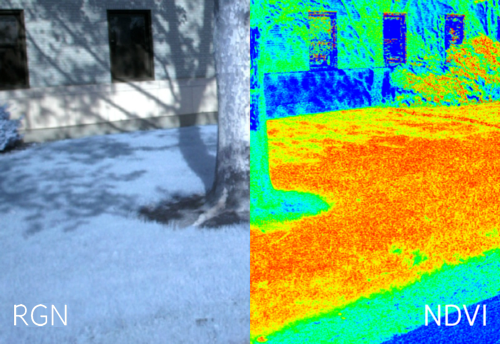](/i/45468?s=o) **** ## NRG imagery Some people are also interested in producing NRG imagery (like the below image), where `Near-Infrared, Red, and Green` are used to compose a picture instead of the usual `Red, Green, and Blue`. [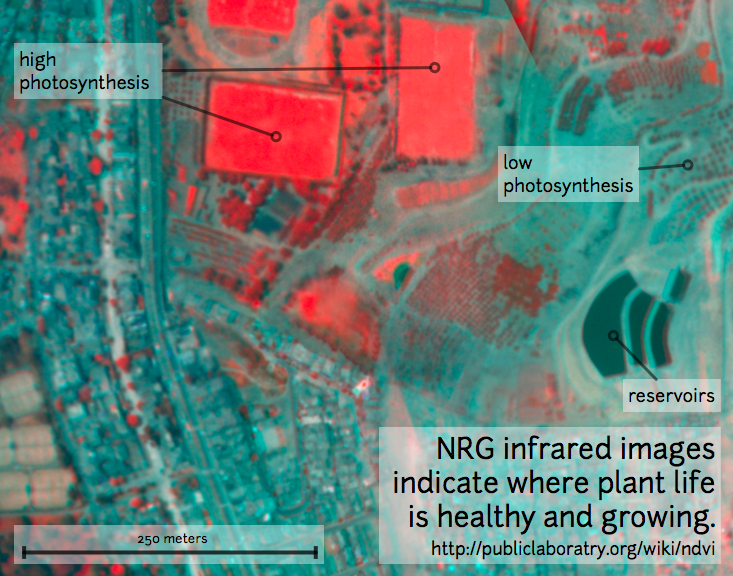](/i/25064) This diagram explains the swapping, which allows us to 'see' infrared as if it were a normal color: [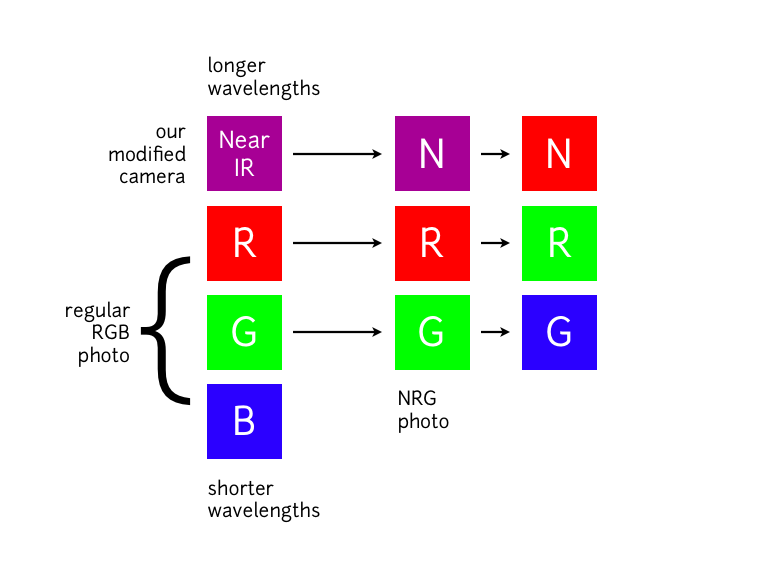](/i/25063) **In NRG images, the deeper and clearer the red color, the denser and healthier the vegetation (more or less).** ### Questions [questions:ndvi] ### Other examples of DIY NDVI imaging From around the internet: Begin watching at 2 minutes to see the resulting imagery: *This topic is part of the [Grassroots Mapping Curriculum](/wiki/mapping-curriculum) series.* **** [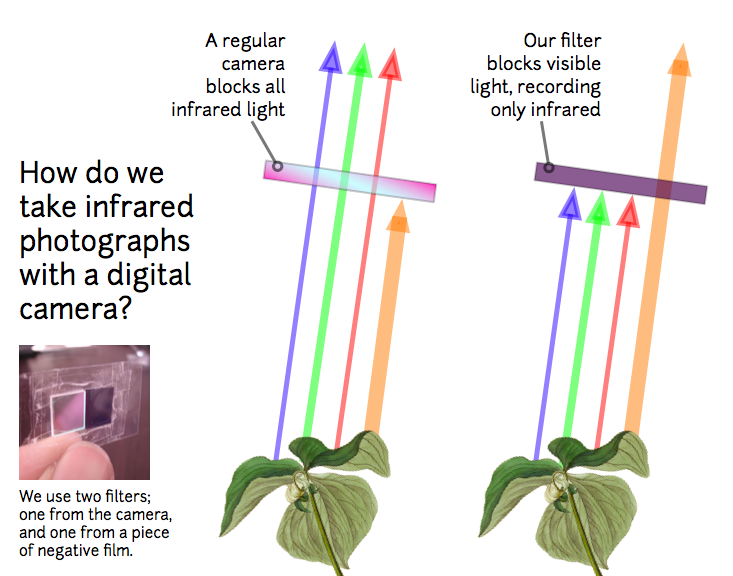](/i/25066) [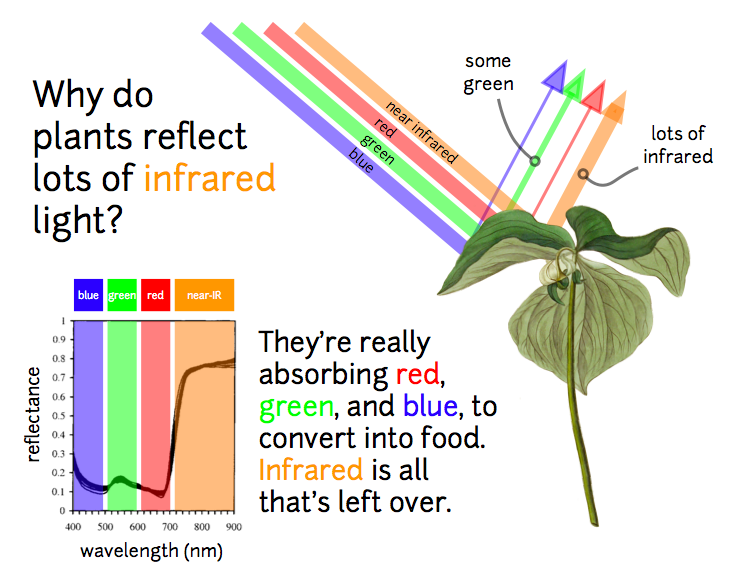](/i/25065) ...
| Author | Comment | Last activity | Moderation | ||
|---|---|---|---|---|---|
| jlspereira | "How do I get a GoPro with this multispectral capability? I am quite interested in the subject " | Read more » | over 10 years ago | |||
| cfastie | " ...the NIR reflectance of the target affects how much the red/green/blue bayer mosaic filter allows through to the sensor. Roolark, I would thin..." | Read more » | over 10 years ago | |||
| nedhorning | "Hi Roolark - Thanks for posting your comments and sharing your research. I don't know if you can post a link to your thesis but I'd be interested ..." | Read more » | over 10 years ago | |||
| Roolark | "Ned, I'm not sure how much this information would help you out here, but I just finished my research thesis, which looked at the NIR sensitivity of..." | Read more » | over 10 years ago | |||
| funkycbj | "A blue filter will give better results if red or yellow flowers are present because the flower reflectance mixes with the leaf reflectance and defl..." | Read more » | over 10 years ago | |||
| warren | "Here is Mathew's PDF on conversion, as well, for reference: mobius_instructions.pdf " | Read more » | over 10 years ago | |||
| cfastie | "Hi Kendrick90, You're right that single camera systems have their limitations. The Wratten 25A camera produces a very good NIR channel (blue) with ..." | Read more » | over 10 years ago | |||
| kendrick90 | "I initially found this site while searching for automatic insect recognition because I'm interested in the potential for robots to help us by shoot..." | Read more » | over 10 years ago | |||
| nedhorning | "I guess it's not actually an extra step. When I do the regression I'm comparing the JPEG pixel values that I adjusted with my inverse gamma (un)cor..." | Read more » | over 10 years ago | |||
| cfastie | "What is the additional step to get a reflectance value? You are estimating the brightness of the reflected light arriving at the camera by using a ..." | Read more » | over 10 years ago | |||
| nedhorning | "Chris, What you describe is part of what I'm trying to do. I want to take your description one step further so that the “new value” represents a p..." | Read more » | over 10 years ago | |||
| cfastie | "How close is this to what you are trying to do? NDVI depends on the difference between two values: the amount of near infrared light (in a parti..." | Read more » | over 10 years ago | |||
| nedhorning | "Hi jdburnett – It sounds like you have quite a nice collection of cameras. It would be great to run some calibration tests with different cameras a..." | Read more » | over 10 years ago | |||
| cfastie | "Ned, From Mary’s scans, you knew the reflectance of your colored targets for every visible and near infrared wavelength. But it looks like you used..." | Read more » | over 10 years ago | |||
| jdburnett | "Ned, thank you for your tremendous effort in this field. I have been following your work here and reviewing Geert Verhoeven's previous research ve..." | Read more » | over 10 years ago | |||
| nedhorning | "Chris - Here are some comments to your first round of questions: How does this apply to dual camera systems, or does it apply only to single camer..." | Read more » | over 10 years ago | |||
| cfastie | "Ned, This approach looks really promising. I was writing a comment about how this fit in with our current way of making NDVI when I realized I did..." | Read more » | over 10 years ago | |||
| mathew | "I was having trouble getting the white balance settings to load. figured it out from a manual editing page on RC groups: http://www.rcgroups.com/fo..." | Read more » | over 10 years ago | |||
| cfastie | "Thanks, download works! Mathew, The white balance settings for both of your Mobius shots at infragram.org are 288, 256, 432. That suggests the came..." | Read more » | over 10 years ago | |||
| warren | "Added! " | Read more » | over 10 years ago | |||
| warren | "Ah, good call. There are a zillion features we need to add to Infragram, but I think i can add that one reasonably fast. Let me try. " | Read more » | over 10 years ago | |||
| cfastie | "I couldn't find a way to download Mathew's original Infragram from Infragram.org. Is there a way? All I could get was the result image. " | Read more » | over 10 years ago | |||
| mathew | "sure image is here. " | Read more » | over 10 years ago | |||
| warren | "Yeah that doesn't look like it's working at all -- can you link to your Infragrammar.org image so I can try to debug? " | Read more » | over 10 years ago |